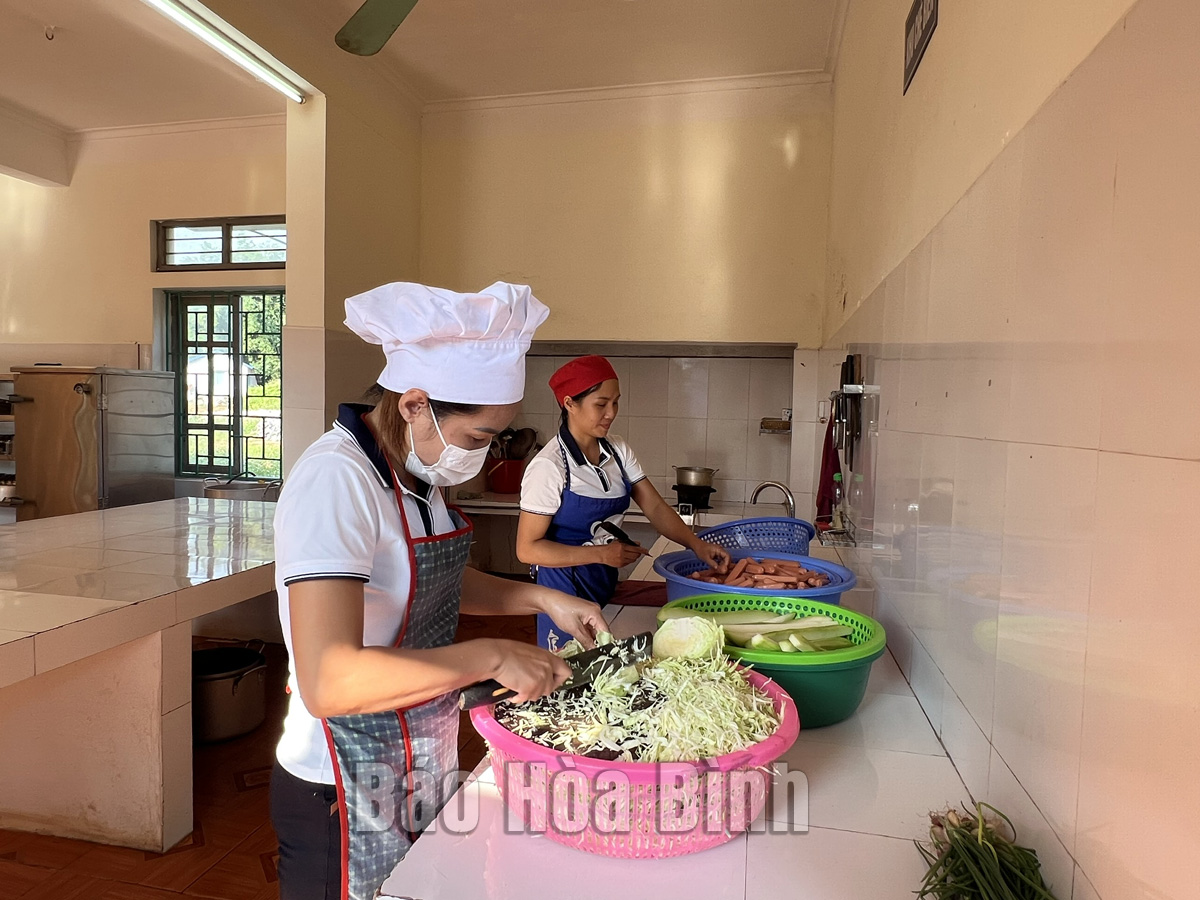
(HBO) - In 2018, Hoa Binh city was recognised as fulfilling new-style rural building criteria. However, after Ky Son district merged into the city in 2020, some communes had not yet met the standards of new-style rural areas so Hoa Binh has continued to implement the task.
As of May 30, the city has six out of seven communes that had
fulfilled new-style rural area building criteria. With high consensus,
determination and joint effort of the whole political system, Hoa Binh city is
trying to meet all the criteria and new-style rural building targets.
The
canteen of the Doc Lap Primary and Secondary Semi-boarding School for ethnic
minorities in Doc Lap commune (Hoa Binh city) meets the requirements of food
hygiene and safety.
Doc Lap, an upland commune with extreme difficulties, has six hamlets with 626
households and 2,948 people. Nguyen Ngoc Que, Chairman of the commune People's
Committee, said that this year the locality is striving to fulfill all 19
new-style rural building criteria. Along with speeding up the construction of
traffic works and cultural institutions, the commune has step up dissemination
and mobilised people to change the crop structure and expand agricultural
production models with high value as well as associating agricultural production
with the development of commerce, services and tourism, he said, adding that it
is striving to reduce the number of poor households to 11.48%in 2023.
Defining that restructuring the agricultural sector towards
increasing added value and sustainable development is the utmost goal and a
breakthrough factor in its socio-economic development, the city has
synchronously implemented measures to restructure agriculture to make it
suitable to the potential and advantages of each region.
Hoa Binh city has also carried out the One Commune One Product
(OCOP) programme in association with creating favourable conditions for
enterprises to invest in and create a linkage in the sale of agricultural
products in the locality. The city has 18 products that are rated as 3- and
4-star OCOP products.
Along with encouraging people to change the structure of crops
and livestock, communes have strived to upgrade cultural and sports facilities
at communes and villages as well as embellish cultural heritages associated
with rural tourism development.
Over the past three years, the city has built two cultural
houses with nearly 700 seats, ensuring they meet the demands relating to the
organisation of major events, festivals and meetings. Up to 22 cultural houses
have been constructed in communes, wards and hamlets in the period. The city
has continued to direct communes to focus on building and upgrading other 62
cultural houses so that all communes will soon complete the criteria for
cultural facilities.
Hoa Binh has mobilised nearly 565 trillion VND (24 million USD) from the State
budget and the contribution of businesses and people for the new-style rural
building programme. Up to now, six out of the seven communes in the city have
met criteria relating to transport. The quality of education, health care,
medical examination and treatment for local residents has been significantly
improved while social order and safety have been maintained.
Do Viet Trieu, Vice Chairman of the Hoa Binh City People's Committee, said that
despite achieving positive results, it is not easy to fulfill the new-style
rural building targets. He cited the fact that some communes were recognised as
meeting news-style rural building standards for the 2016-2020 period but failed
to satisfy the criteria for the 2021-2025 period.
There remained difficulties relating to adjustments in
accordance with regulations on the planning work, especially the merged
communes. Therefore, the municipal People's Committee requested the communes to
maintain the criteria that have been fulfilled and devise solutions to those
that haven’t been met in line with a specific roadmap, he said./.
The Standing Board of the Hoa Binh provincial Party Committee met on March 18 to review and guide major investment projects aimed at boosting local socio-economic development.
The air is thick with the hum of drills and the clatter of machinery as the Hoa Binh – Moc Chau expressway takes shape amid the rugged terrain. Welding sparks illuminate the faces of workers, and concrete mixers churn relentlessly, laying fresh pavement on the newly-carved road. The construction site buzzes with a palpable sense of urgency, particularly in Hoa Binh province where the expressway's future is being forged.
The northern province of Hoa Binh, with over 467,000 hectares of natural forest and more than 100,000 hectares of production forest, holds significant potential for carbon credit market development.
Replacing substandard houses with more sturdy ones by June 30 is the direction given by Nguyen Phi Long, alternate member of the Party Central Committee and Secretary of the Hoa Binh provincial Party Committee, at a meeting held in early March by the provincial Steering Committee for the programme to eliminate temporary and dilapidated houses for the needy.
Recognising digital transformation as an inevitable trend, authorities and agencies in Hoa Binh have made great efforts in the work by focusing on three core pillars - digital government, digital society, and digital economy, resulting in enhanced competitiveness, improved investment climate, and ensured economic and social welfare.
In recent years, Da Bac district has improved administrative reform with a one-stop shop mechanism, streamlined inter-agency procedures, and a shift to digital platforms. These efforts have enhanced public service efficiency and contributed to local socio-economic development.



